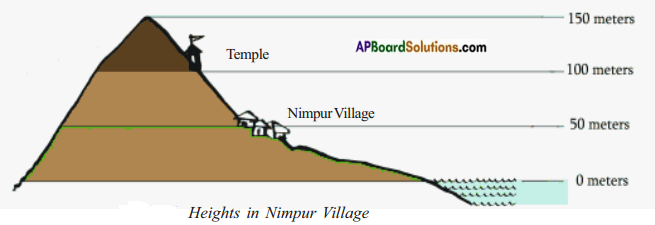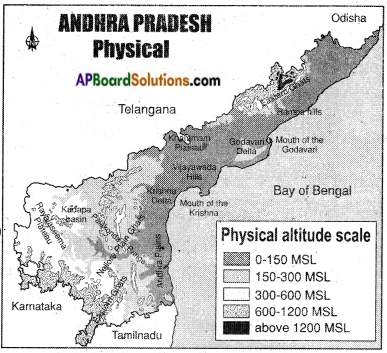Andhra Pradesh Board Class 7th Social Studies Chapter 1 Reading Maps of Different Kinds Textbooks Solutions PDF
Andhra Pradesh State Board STD 7th Social Studies Chapter 1 Reading Maps of Different Kinds Books Solutions with Answers are prepared and published by the Andhra Pradesh Board Publishers. It is an autonomous organization to advise and assist qualitative improvements in school education. If you are in search of AP Board Class 7th Social Studies Chapter 1 Reading Maps of Different Kinds Books Answers Solutions, then you are in the right place. Here is a complete hub of Andhra Pradesh State Board Class 7th Social Studies Chapter 1 Reading Maps of Different Kinds solutions that are available here for free PDF downloads to help students for their adequate preparation. You can find all the subjects of Andhra Pradesh Board STD 7th Social Studies Chapter 1 Reading Maps of Different Kinds Textbooks. These Andhra Pradesh State Board Class 7th Social Studies Chapter 1 Reading Maps of Different Kinds Textbooks Solutions English PDF will be helpful for effective education, and a maximum number of questions in exams are chosen from Andhra Pradesh Board.Andhra Pradesh State Board Class 7th Social Studies Chapter 1 Reading Maps of Different Kinds Books Solutions
| Board | AP Board |
| Materials | Textbook Solutions/Guide |
| Format | DOC/PDF |
| Class | 7th |
| Subject | Maths |
| Chapters | Social Studies Chapter 1 Reading Maps of Different Kinds |
| Provider | Hsslive |
How to download Andhra Pradesh Board Class 7th Social Studies Chapter 1 Reading Maps of Different Kinds Textbook Solutions Answers PDF Online?
- Visit our website - Hsslive
- Click on the Andhra Pradesh Board Class 7th Social Studies Chapter 1 Reading Maps of Different Kinds Answers.
- Look for your Andhra Pradesh Board STD 7th Social Studies Chapter 1 Reading Maps of Different Kinds Textbooks PDF.
- Now download or read the Andhra Pradesh Board Class 7th Social Studies Chapter 1 Reading Maps of Different Kinds Textbook Solutions for PDF Free.
AP Board Class 7th Social Studies Chapter 1 Reading Maps of Different Kinds Textbooks Solutions with Answer PDF Download
Find below the list of all AP Board Class 7th Social Studies Chapter 1 Reading Maps of Different Kinds Textbook Solutions for PDF’s for you to download and prepare for the upcoming exams:7th Class Social Studies 1st Lesson Reading Maps of Different Kinds Textbook Questions and Answers
Improve Your Learning
Question 1.
Why are the levels of all the seas equal in the world?
Answer:
All heights on the land are calculated from the sea level. Since all seas in the world are connected to each other, more or less the sea level (the top surface) all over the world is taken to be roughly the same.
We can easily observe this in the picture given below.
The temple is 100 meters high above sea level. The top of the hill is 150 meters high from sea level.
Thus we can say the levels of all the seas are equal in the world.
Question 2.
How is the sea level measured?
Answer:
The level of the sea keeps changing. So the level of the sea is carefully measured at frequent intervals and the mean level of the sea is calculated. A tidal gauge is used to measure the rising and falling of the sea.
Question 3.
What are the uses of maps showing heights?
Answer:
- These maps help us to understand the nature of the terrain, where the mountains are, where the valleys are, etc.
- If we look at the physical map of Andhra Pradesh, we can identify the coastal plains that run along the coast of the Bay of Bengal.
- If we travel westwards from the coast, we will reach hills that form the “escarpments” to the plateau region.
- The plateau region itself is cut by many rivers like the Krishna and the Godavari which form deep and broad valleys in them.
- Maps showing heights are very essential when roads or dams have to be constructed.
- If we have to lay roads in an undulating region between two places, such maps help us in deciding the route to be taken by the road.
- Similarly, when dams are planned it is necessary to know how much land will be submerged by the water of the dam.
Question 4.
What differences do you find between the lifestyle of people living on high altitudes and low altitudes?
Answer:
Difference between the people living on the high and low altitudes:
| People of High Altitudes | People of Low Altitudes |
| 1) They live in mountainous regions. | 1) They live in plains. |
| 2) They are economically backward. | 2) They are economically well developed. |
| 3) They wear woolen clothes. | 3) They wear cotton and silk clothes. |
| 4) They enjoy insecure life. | 4) They enjoy secure life. |
Question 5.
How are maps helpful to people?
Answer:
- The map is a representation or a drawing of the total or a part of the earth’s surface drawn on a flat surface according to a scale.
- Maps help us to study a part of the earth.
- Maps provide more information than a globe.
- Maps are easy to carry and take the measurement too.
- Some maps tell us about how high or low the places are, some tell us about how much it rains there or how hot or cold it gets there.
- Some maps tell us about crops that grow there or the kinds of forests there are.
- By studying them we can know much about a place.
Question 6.
Read the para ‘Contour Lines’ and comment on it.
Contour Lines
A contour is a line joining the places with equal heights. On the map of Nimpur you would have seen that there is a line passing through the village, this is the 50-meter contour line. All places on this line will have the same height of 50 meters. Contour lines will be in irregular shape depending upon the landform. These cannot cut with each other. The distance between two contour lines will depend upon the landscape. If the land has a steep climb then the contour lines will be near to each other. If the slope of the land is gentle, then the contour lines will be quite far from each other.
Answer:
A contour line of a function of two variables is a curve along which the function has a constant value. In cartography, a contour line joins points of equal elevation above a given level, such as mean sea level.
Contour lines are curved, straight or a mixture of both lines on a map describing the intersection of a real surface with one or more horizontal plains.
Question 7.
Observe the physical map of Andhra Pradesh and list out the districts which are above 150 M.S.L.?
Answer:
The following districts are above 150 mts Mean Sea level.
- Chittoor
- Visakhapatnam
- Kurnool
- Anantapur.
AP Board Textbook Solutions PDF for Class 7th Social Studies
- AP Board Class 7
- AP Board Class 7 Social Studies
- AP Board Class 7 Social Studies 1st Lesson The Universe and The Earth
- AP Board Class 7 Social Studies 2nd Lesson Forests
- AP Board Class 7 Social Studies 3rd Lesson Learning Through Maps
- AP Board Class 7 Social Studies 4th Lesson Delhi Sultanate
- AP Board Class 7 Social Studies 5th Lesson Kakatiya Kingdom
- AP Board Class 7 Social Studies 6th Lesson Vijayanagara Empire
- AP Board Class 7 Social Studies 7th Lesson Mughal Empire
- AP Board Class 7 Social Studies 8th Lesson Bhakthi Sufi
- AP Board Class 7 Social Studies 9th Lesson Indian Constitution
- AP Board Class 7 Social Studies 10th Lesson State Government
- AP Board Class 7 Social Studies 11th Lesson Road Safety Education
- AP Board Class 7 Social Studies 12th Lesson Markets Around Us
- AP Board Class 7 Social Studies 13th Lesson Women Change the World
- AP Board Class 7 Social Studies Chapter 1 విశ్వం మరియు భూమి
- AP Board Class 7 Social Studies Chapter 2 అడవులు
- AP Board Class 7 Social Studies Chapter 3 పటాల ద్వారా అధ్యయనం
- AP Board Class 7 Social Studies Chapter 4 ఢిల్లీ సుల్తానులు
- AP Board Class 7 Social Studies Chapter 5 కాకతీయ రాజ్యం
- AP Board Class 7 Social Studies Chapter 6 విజయనగర సామ్రాజ్యం
- AP Board Class 7 Social Studies Chapter 7 మొఘల్ సామ్రాజ్యం
- AP Board Class 7 Social Studies Chapter 8 భక్తి – సూఫీ
- AP Board Class 7 Social Studies Chapter 9 భారత రాజ్యాంగం – పరిచయం
- AP Board Class 7 Social Studies Chapter 10 రాష్ట్ర ప్రభుత్వం
- AP Board Class 7 Social Studies Chapter 11 రహదారి భద్రత
- AP Board Class 7 Social Studies Chapter 12 మన పరిసరాలలో ఉన్న మార్కెట్లు
- AP Board Class 7 Social Studies Chapter 13 ప్రపంచ పరివర్తనలో మహిళలు
- AP Board Class 7 Social Studies Chapter 1 Reading Maps of Different Kinds
- AP Board Class 7 Social Studies Chapter 2 Rain and Rivers
- AP Board Class 7 Social Studies Chapter 3 Tanks and Ground Water
- AP Board Class 7 Social Studies Chapter 4 Oceans and Fishing
- AP Board Class 7 Social Studies Chapter 5 Europe
- AP Board Class 7 Social Studies Chapter 6 Africa
- AP Board Class 7 Social Studies Chapter 7 Handicrafts and Handlooms
- AP Board Class 7 Social Studies Chapter 8 Industrial Revolution
- AP Board Class 7 Social Studies Chapter 9 Production in a Factory A Paper Mill
- AP Board Class 7 Social Studies Chapter 10 Importance of Transport System
- AP Board Class 7 Social Studies Chapter 11 New Kings and Kingdoms
- AP Board Class 7 Social Studies Chapter 12 The Kakatiyas
- AP Board Class 7 Social Studies Chapter 13 The Kings of Vijayanagara
- AP Board Class 7 Social Studies Chapter 14 Mughal Empire
- AP Board Class 7 Social Studies Chapter 15 Establishment of the British Empire in India
- AP Board Class 7 Social Studies Chapter 16 Making of Laws in the State Assembly
- AP Board Class 7 Social Studies Chapter 17 Implementation of Laws in the District
- AP Board Class 7 Social Studies Chapter 18 Caste Discrimination and the Struggle for Equality
- AP Board Class 7 Social Studies Chapter 19 Livelihood and Struggles of Urban Workers
- AP Board Class 7 Social Studies Chapter 20 Folk Religion
- AP Board Class 7 Social Studies Chapter 21 Devotional Paths to the Divine
- AP Board Class 7 Social Studies Chapter 22 Rulers and Buildings







0 Comments:
Post a Comment